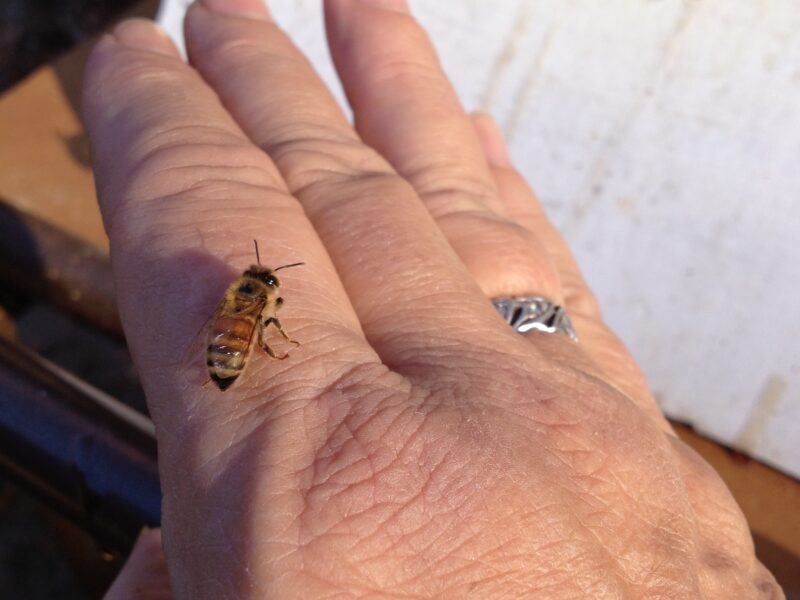
As you may have heard mentioned once or twice in recent weeks, the long-reigning monarch of England, Queen Elizabeth II, passed away in September at the age of 96. As one would expect, there was a tremendous outpouring of pomp and circumstance in the aftermath of her death — processions, speeches, miles-long queues of mourners waiting to walk past her coffin and pay their respects.
One bit of arcana that several people have asked me about is the tradition of “telling the bees” the queen had died. Apparently, the British royal household is home to seven beehives, five at Buckingham Palace and two at Clarence House.
Honeybees do become familiar with the person who disrupts their home on a regular basis, but it probably won’t surprise you to learn that Queen Elizabeth wasn’t donning a bee suit and pulling frames up out of the hives when she needed honey for her tea. So it’s not like her bees would have noticed that the person caring for them had suddenly vanished. The royal beekeeper, John Chapple, is still on the job — and it fell to him to tell the bees about her passing, even though one could logically assume that the news wasn’t all that relevant to their lives.
But then, what has logic ever had to do with tradition? I was sort of familiar with the concept of telling the bees, though I never gave the “why” behind it much thought. But once people started asking me about it, I decided to do some research. Turns out that telling the bees is a practice that dates back to at least the 18th century and is thought to have originated in Ireland. The gist of it is that when a significant life event occurs, like a death, marriage or the birth of a child, it falls to a trusted soul — the beekeeper — to share the news with the bees. As with most traditions based on vague superstitions, the “rules” of telling the bees are far from hard and fast.
Personally, I did make a point of telling my bees last year when my father-in-law passed away in Ireland. Not because I was afraid they’d hear it through some insect grapevine and be angry they hadn’t been told, but because I generally talk or sing to them most of the time while I’m working in the hives, anyway, and Mike’s death weighed heavy on my heart. Since I seem genetically incapable of having a thought and not talking about it, I told them he had passed and that he was a great man who had enjoyed their honey over the years.
Anyway, back to why we tell them. In Celtic mythology, the sighting of a bee after a death was thought to signify the soul leaving the body, so maybe telling the bees grew from there. From its Irish roots, the practice of telling the bees spread to the United States and Western Europe. Traditions vary from one place to another, but the general practice is that each hive must be told separately. The beekeeper will often knock on the wall of the hive to alert the bees to his presence, then inform them of the death.
That’s what Chapple did, according to various media reports, saying, “You knock on each hive and say, ‘The mistress is dead, but don’t you go. Your master will be a good master to you.’” If the hive responds with elevated buzzing, it’s considered a good sign that the bees have heard the news and can act accordingly. Often, hives are draped with black cloth after being told the sad news.
In 1858, English poet John Greenleaf Whittier immortalized the practice in his poem “Telling the Bees,” in which a long-lost lover returns to find a young girl draping the home’s hives with “shred of black” and singing, “Stay at home, pretty bees, fly not hence! Mistress Mary is dead and gone!”
In some places, common practice called for the bees to be told at midnight, and in others, for the hives to be turned so their entrances faced the beekeeper’s home.
Failing to tell the bees, according to legend, can lead to the bees dying or leaving. One story out of Norfolk, England, reports that a family purchased a hive at auction, and the bees were sickly and seemed doomed. The family learned that the bees had not been told of their prior owner’s death, so they attached black crepe to the hive and told the bees the news, reassuring them that they would continue to be well cared for. The bees reportedly thrived. I remain skeptical.
This all seems ridiculous, of course, but sometimes you do have to wonder about the bond between a beekeeper and his furry little charges. In 1956, The North Adams (Massachusetts) Transcript reported on the death of John Zepka, a florist and beekeeper:
“Throughout his long life, the late John Zepka of 21 Victory Street had raised, worked with and loved bees and was widely known in this section as a man who ‘had a way with them.’
“This morning it appeared as though the bees had taken their own way of paying a final tribute to him.
“When his funeral cortege reached the grave in St. Stanislaus cemetery they found the funeral tent literally swarming with bees. They were all over the tent ceiling and clinging to the profuse floral sprays. They made no attempt to annoy the mourners, just remained almost immobile. Persons who saw the spectacle declared that they had never seen anything like it before.”
I guess if the bees can bother to show up for a funeral, the least we can do is let them know when one is imminent.